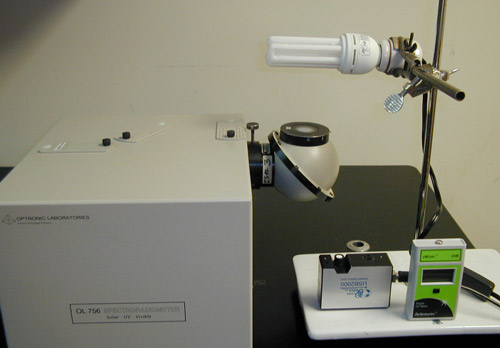Bonus content from the April 2011 REPTILES magazine article "Rethinking Reptile Lighting" by Shane Bagnall.
Specialty lighting for the reptile hobbyist is essential to assure the best possible health of specimens. Optimal lighting provides not only good color rendering but also UV radiation necessary for vitamin D synthesis and regulation of circadian and seasonal behaviors in some species. A variety of measurement tools exist to quantify and monitor the UV output of reptile lamps.
The most accessible are inexpensive meters in the $100-to-$200 range. Meters are made to respond to a select portion of the spectrum but cannot distinguish spectral differences within their window of response. However, meters are quite valuable for monitoring output as lamps age and become less effective.

John C. Dowdy
Seen here is a Gooch & Housego model OL-756 scanning double-grating monochromator spectroradiometer (left) alongside a Solartech model 6.2 UV-B Solarmeter digital ultraviolet radiometer (right). Both are used to measure light.
Miniature solid state spectrometers, ranging in price from $2,000 to $3,000, offer some resolution of a lamp’s spectral output but lack the ability to discern sharp changes in spectral curves and can falsely read out of band energy from other parts of the spectrum as UV. These spectrometers also lack dynamic range to fully analyze or certify the actual UV effectiveness of a reptile lamp but do offer some spectral information not possible from meters.
The gold standard for biological effectiveness measurements of UV sources is the scanning double monochromator spectroradiometer. This is a scientific research-grade instrument that can cost $50,000 or more, depending on configuration. It is obviously beyond practicality for most, save large lamp manufacturers, specialty testing laboratories and national reference institutes. This instrument possesses the dynamic range, spectral resolution and stray light rejection required to fully evaluate UV sources of all kinds. To put this into perspective, scanning double monochromators are used to calibrate meters and spectrometers, and international standards for photosafety classification of sources for human risks specify this type of instrument.
Proper analysis of reptile lamps follows many of the same type of analysis calculations as human safety and effectiveness does. Consequently, lamps subjected to such stringent evaluation are assured to provide the output claimed.
John C. Dowdy, Ph.D., is a photobiologist at Rapid Precision Testing Laboratories (RapidPrecision.com) in Cordova, Tenn. He is an expert in spectral measurement, risk analysis and certification of solar simulators, sunlamps, photomedical lamps and other light sources.
Want to read the full story? Pick up the April 2011 issue of REPTILES, or subscribe to get 12 months of articles just like this.


